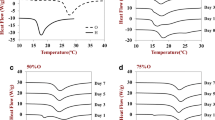Abstract
The performance of solid lipid nanoparticles is often modified by the addition of small amounts of liquid oil. The effects of added liquid lipid (tetradecane, C14) on the distribution and reactivity of the spin probe 4-phenyl-2,2,5,5-tetramethyl-3-imidazoline-1-oxyl nitroxide (PTMIO) in solid lipid nanoparticles (eicosane, C20) were investigated as a function of storage time and temperature. Emulsions prepared with blends of C14:C20 (100 % C14, 90 % C20, 99 % C20, and 100 % C20) and stabilized by sodium caseinate (1 wt%) were stored at 21.5 °C or 5 °C for 5 or 24 h prior to EPR analyses. In the liquid C14 droplets the PTMIO partitioned between the droplet and aqueous phases (70 and 30 %, respectively) independent of storage conditions. However, the proportion of probe in droplets decreased with increasing crystalline C20 concentration. The fraction of PTMIO in droplets containing C20 decreased in the following sequence: 5 h at room temperature >24 h at room temperature >24 h at refrigerated temperature and was lower in droplets with a higher proportion of C20. The residual PTMIO in semicrystalline droplets has higher polarity and lower mobility than PTMIO in liquid oil droplets suggesting it is in a layer surrounding the crystalline lipid core, and partly immobilized by interaction with the surface layer. The model of PTMIO distribution was consistent with the kinetics of PTMIO reduction by aqueous ascorbate ions.



Similar content being viewed by others
References
Acosta E (2009) Bioavailability of nanoparticles in nutrient and nutraceutical delivery. Curr Opin Coll In 14(1):3–15
McClements DJ, Decker E, Weiss J (2007) Emulsion-based delivery systems for lipophilic bioactive components. J Food Sci 72(8):109–124
Muller RH, Mader K, Gohla S (2000) Solid lipid nanoparticles (SLN) for controlled drug delivery—a review of the state of the art. Eur J Pharm Biopharm 50:161–177
Yucel U, Elias RJ, Coupland JN (2012) Solute distribution and stability in emulsion-based delivery systems: an EPR study. J Coll Int Sci 377:105–113
Muller RH, Radtke M, Wissing SA (2002) Nanostructures lipid matrices for improved microencapsulation of drugs. Int J Pharm 242:121–128
Souto EB, Wissing SA, Barbosa CM, Muller RH (2004) Development of a controlled release formulation based on SLN and NLC for topical clotrimazole delivery. Int J Pharm 278:71–77
Jenning V, Thunemann AF, Gohla SH (2000) Characterization of a novel solid lipid nanoparticle carrier system based on binary mixtures of liquid and solid lipids. Int J Pharm 199:167–177
Jenning V, Mader K, Gohla SH (2000) Solid lipid nanoparticles (SLN) based on binary mixtures of liquid and solid lipids: a H-NMR study. Int J Pharm 205:15–21
Jores K, Mehnert W, Drechsler M, Bunjes H, Johann C, Mader K (2004) Investigations on the structure of solid lipid nanoparticles (SLN) and oil-loaded solid lipid nanoparticles by photon correlation spectroscopy, field-flow fractionation and transmission electron microscopy. J Control Release 95:217–227
Ghosh S, Peterson DG, Coupland JN (2007) Aroma release from solid droplet emulsions: effect of lipid type. J Am Oil Chem Soc 84:1001–1014
Jores K, Mehnert W, Mader K (2003) Physicochemical investigations on solid lipid nanoparticles and on oil-loaded solid lipid nanoparticles: a nuclear magnetic resonance and electron spin resonance study. Pharm Res 20(8):1274–1283
Gulseren I, Coupland JN (2007) The effect of emulsifier type and droplet size on phase transitions in emulsified even-numbered n-alkanes. J Am Oil Chem Soc 84(7):621–629
Gulseren I, Coupland JN (2008) Surface melting in alkane emulsion droplets as affected by surfactant type. J Am Oil Chem Soc 85(5):413–419
Sirota EB (1998) Supercooling, nucleation, rotator phases, and surface crystallization of n-alkane melts. Langmuir 14:3133–3136
Kraack H, Sirota EB, Deutsch M (2000) Measurements of homogeneous nucleation in normal-alkanes. J Chem Phys 112(15):6873–6885
Sirota EB, Herhold AB (1999) Transient phase-induced nucleation. Science 283:529–532
Bunjes H, Drechsler M, Koch MHJ, Westesen K (2001) Incorporation of the model drug Ubidecarenone into solid lipid nanoparticles. Pharm Res 18(3):287–293
Bunjes H, Koch MHJ, Westesen K (2000) Effect of particle size on colloidal solid triglycerides. Langmuir 16:5234–5241
Jenning V, Schafer-Korting M, Gohla S (2000) Vitamin A-loaded solid lipid nanoparticles for topical use: drug release properties. J Control Release 66:115–126
Jenning V, Gohla SH (2001) Encapsulation of retinoids in solid lipid nanoparticles (SLN). J Microencapsul 18(2):149–158
Kristl J, Volk B, Gasperlin M, Sentjurc M, Jurkovic P (2003) Effect of colloidal carriers on ascorbyl palmitate stability. Eur J Pharm Sci 19:181–189
Acknowledgments
This work was supported by a grant from USDA-AFRI program (Award number 2009-65503-05960, program code 93430).
Author information
Authors and Affiliations
Corresponding author
About this article
Cite this article
Yucel, U., Elias, R.J. & Coupland, J.N. Effect of Liquid Oil on the Distribution and Reactivity of a Hydrophobic Solute in Solid Lipid Nanoparticles. J Am Oil Chem Soc 90, 819–824 (2013). https://doi.org/10.1007/s11746-013-2228-x
Received:
Revised:
Accepted:
Published:
Issue Date:
DOI: https://doi.org/10.1007/s11746-013-2228-x




